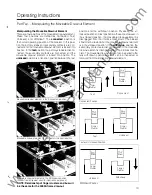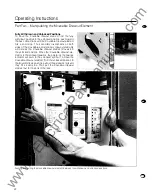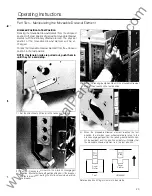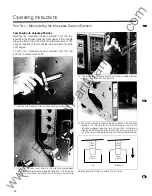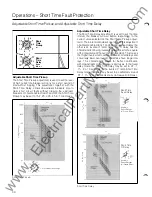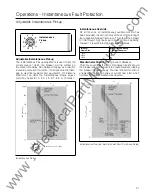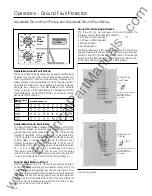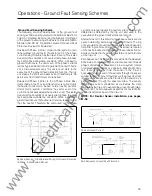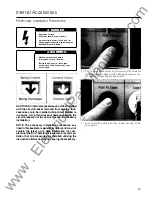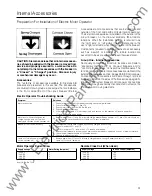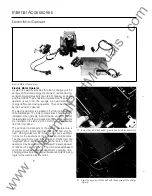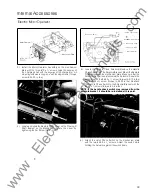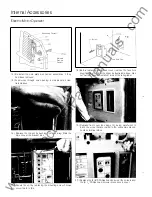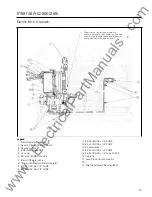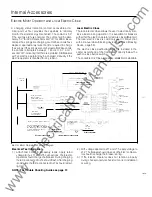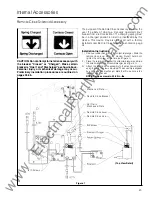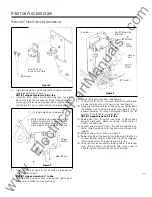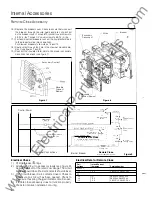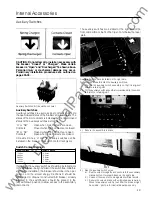
Operating Instructions
Part Three - Monitoring the Electronic Trip Unit
Trip Unit Test and Monitoring Functions
Siemens Electronic Trip Unit is equipped with three stan
dard test and monitoring functions to aid the user in the
installation and operation of the SB breaker.
System Check Indicator
%1,
Continuous
·.
1 00
95
0
SYSTEM
CHECK
The System Check Indicator is a green LED that blinks
approximately once every 3 seconds when the micropro
cessor is properly cycling through its protection routines.
The trip unit derives its operating power from the phase
currents in the SB breaker. The phase current required to
operate the trip unit is approximately 20 percent of the frame
rating (1,). If the microprocessor is not properly cycling
through its protection routines, the phase current is below
20% In, the LED will not light.
Trip Status
Trip
Status
O.L.
S.T.
S.C .
G.F.
The trip Query button and Trip Status indicator lights
provide the user the means for determining what type of
fault caused the trip unit to trip the breaker. Fault indicators
are provided for:
O.L. - Overload or Long Time Fault
S.T. - Short Time Fault
S.C. - Short Circuit or Instantaneous Fault
G . F. - G round Fault
When a fault occurs, the fault information is stored in the
trip unit by latching the appropriate red LED fault indica
tor to the "On" position. When the Query button is de
pressed, the latched fault indicator will light. The electrical
power to the indicators is automatically stored in the trip
unit, eliminating the need for a battery pack. A hole is
provided in the transparent cover to allow the user access
to the Query button.
NOTE: During trip unit power up, the S.C. fault indica
tor will latch, providing a means to check that the
circuitry is properly operating. In the case of a fault,
the proper indicator will be latched to the fault posi
tion. The indicator circuitry always latches the most
recent event.
34
Integral Test Modes
The i ntegral test function enables the user to " exercise" the
trip unit electronics, the magnetic latch, and the breaker
mechanism. The purpose of the integral test function is to
provide the user an easy means to conduct a "go/no go"
type test before bringing the breaker on-line. After the
breaker has been brought on-line, it may be used during
routine inspection and maintenance.
Both phase fault current protection and ground fault current
protection may be tested. The integral ground fault test
function tests the circuit breaker's ground fault protection
system in accordance with NEG Article 230-95(c).
Electrical power to operate the integral test function is
provided internally, if the breaker is closed and the phase
currents are greater than 20% of the frame ampere rating In,
or by a plug-in power source (see Accessories section).
The user may execute the test function in either a "no trip"
mode, which will test only the trip unit electronics, or a "trip"
mode, which will also test the magnetic latch and breaker
mechanism. The execution of the integral test function in
both the "no trip" and "trip" modes is based on the settings
of the long time delay and ground fault delay adjustments.
Therefore, the Phase Test will take several seconds to
execute and the G round Fault Test will appear to be nearly
instantaneous. To execute a test function in the "no trip"
mode, depress the appropriate pushbutton test switch,
Phase
or
GF.
As the trip unit is performing the test, the
Testing
Indicator will light. If the trip unit successfully
passes the test, the
Pass
Indicator will light. If the Pass
Indicator does not light after the Testing I ndicator indicates
that the test is complete, a more extensive test should be run
with Siemens TS-31 Universal Test Kit (see Accessories).
CAUTION: Before conducting a "Trip" test on a SB
breaker which is "Closed" and in service, caution
should be taken to evaluate effects on downstream
loads. The breaker
will
open during testing, resulting
in a disruption of service.
www
. ElectricalPartManuals
. com






